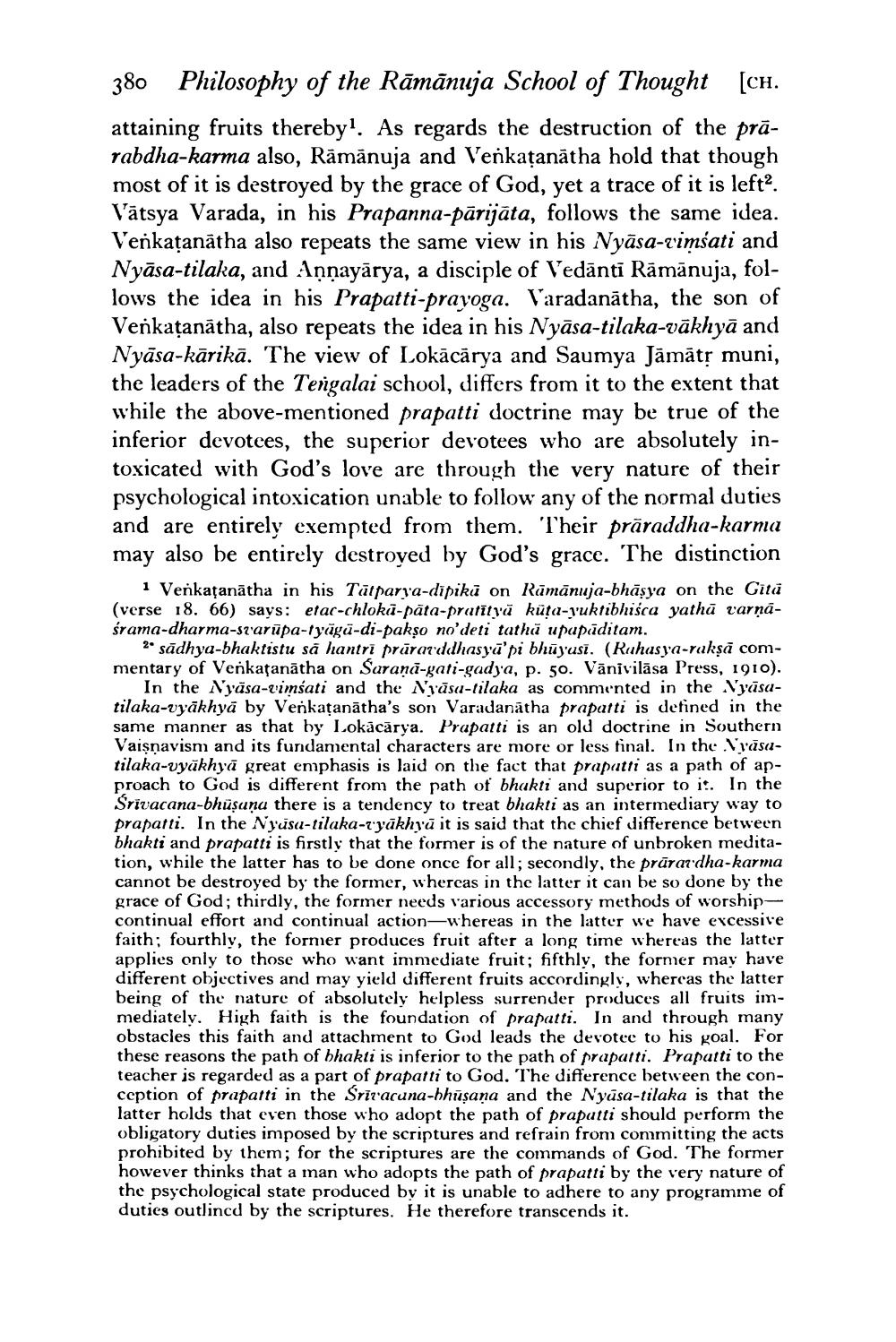________________
380 Philosophy of the Rāmānuja School of Thought [ch. attaining fruits therebyl. As regards the destruction of the prārabdha-karma also, Rāmānuja and Venkațanātha hold that though most of it is destroyed by the grace of God, yet a trace of it is left?. Vātsya Varada, in his Prapanna-pārijāta, follows the same idea. Verkațanātha also repeats the same view in his Nyāsa-vimšati and Nyāsa-tilaka, and Annayārya, a disciple of Vedānti Rāmānuja, follows the idea in his Prapatti-prayoga. Varadanātha, the son of Verkațanātha, also repeats the idea in his Nyāsa-tilaka-vākhyā and Nyāsa-kārikā. The view of Lokācārya and Saumya Jāmātņ muni, the leaders of the Tengalai school, differs from it to the extent that while the above-mentioned prapatti doctrine may be true of the inferior devotees, the superior devotees who are absolutely intoxicated with God's love are through the very nature of their psychological intoxication unable to follow any of the normal duties and are entirely exempted from them. Their prāraddha-karna may also be entirely destroyed by God's grace. The distinction
1 Verkațanātha in his Tātparya-dipiku on Rāmānuja-bhāsya on the Gita (verse 18. 66) says: etac-chloka-pata-pratityū kuta-yuktibhisca yathā varņaśrama-dharma-st'arūpa-Tyagā-di-pakṣo no'deti tathū upapīditam.
2 sādhya-bhaktistu sa hantrī prāravddhasyā'pi bhūyusi. (Rahasya-rakşā commentary of Venkatanātha on Sarana-gati-gadya, p. 50. Vānivilāsa Press, 1910).
In the Nyāsa-vimsati and the Nrāsu-tilaka as commented in the Vyāsutilaka-vyākhyā by Venkațanātha's son Varadanātha prapatti is defined in the same manner as that by Lokācārya. Prapatti is an old doctrine in Southern Vaisnavism and its fundamental characters are more or less final. In the Vyasatilaka-vyākhyā great emphasis is laid on the fact that prapatti as a path of approach to God is different from the path of bhakti and superior to it. In the Srivacana-bhuşunu there is a tendency to treat bhakti as an intermediary way to prapatti. In the Nyusu-tilaka-z'yākhyā it is said that the chief difference between bhakti and prapatti is firstly that the former is of the nature of unbroken meditation, while the latter has to be done once for all; secondly, the prārardha-karma cannot be destroyed by the former, whereas in the latter it can be so done by the grace of God; thirdly, the former needs various accessory methods of worshipcontinual effort and continual action—whereas in the latter we have excessive faith; fourthly, the former produces fruit after a long time whereas the latter applies only to those who want immediate fruit; fifthly, the former may have different objectives and may yield different fruits accordingly, whereas the latter being of the nature of absolutely helpless surrender produces all fruits immediately. High faith is the foundation of prapatti. In and through many obstacles this faith and attachment to God leads the devotee to his goal. For these reasons the path of bhakti is inferior to the path of prapatti. Prapatti to the teacher is regarded as a part of prapatti to God. The difference between the conception of prapatti in the Srītacuna-hhūşana and the Nyāsa-tilaka is that the latter holds that even those who adopt the path of prapatti should perform the obligatory duties imposed by the scriptures and refrain from committing the acts prohibited by them; for the scriptures are the commands of God. The former however thinks that a man who adopts the path of prapatti by the very nature of the psychological state produced by it is unable to adhere to any programme of duties outlined by the scriptures. He therefore transcends it.
* sadharma-svarlik, etar-chloh




